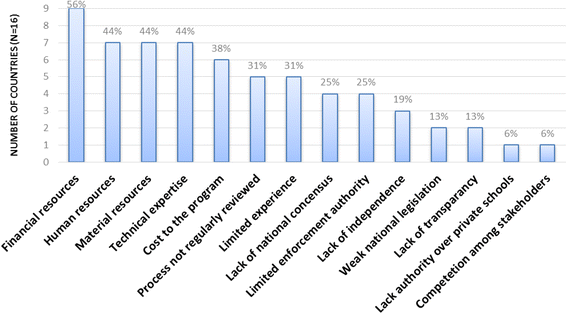Cross-sectional description of nursing and midwifery pre-service education accreditation in east, central, and southern Africa in 2013
- PMID: 28738870
- PMCID: PMC5525227
- DOI: 10.1186/s12960-017-0224-1
Cross-sectional description of nursing and midwifery pre-service education accreditation in east, central, and southern Africa in 2013
Abstract
Background: In 2013, the World Health Organization issued guidelines, Transforming and Scaling Up Health Professional Education and Training, to improve the quality and relevance of health professional pre-service education. Central to these guidelines was establishing and strengthening education accreditation systems. To establish what current accreditation systems were for nursing and midwifery education and highlight areas for strengthening these systems, a study was undertaken to document the pre-service accreditation policies, approaches, and practices in 16 African countries relative to the 2013 WHO guidelines.
Methods: This study utilized a cross-sectional group survey with a standardized questionnaire administered to a convenience sample of approximately 70 nursing and midwifery leaders from 16 countries in east, central, and southern Africa. Each national delegation completed one survey together, representing the responses for their country.
Results: Almost all countries in this study (15; 94%) mandated pre-service nursing education accreditation However, there was wide variation in who was responsible for accrediting programs. The percent of active programs accredited decreased by program level from 80% for doctorate programs to 62% for masters nursing to 50% for degree nursing to 35% for diploma nursing programs. The majority of countries indicated that accreditation processes were transparent (i.e., included stakeholder engagement (81%), self-assessment (100%), evaluation feedback (94%), and public disclosure (63%)) and that the processes were evaluated on a routine basis (69%). Over half of the countries (nine; 56%) reported limited financial resources as a barrier to increasing accreditation activities, and seven countries (44%) noted limited materials and technical expertise.
Conclusion: In line with the 2013 WHO guidelines, there was a strong legal mandate for nursing education accreditation as compared to the global average of 50%. Accreditation levels were low in the programs that produce the majority of the nurses in this region and were higher in public programs than non-public programs. WHO guidelines for transparency and routine review were met more so than standards-based and independent accreditation processes. The new global strategy, Workforce 2030, has renewed the focus on accreditation and provides an opportunity to strengthen pre-service accreditation and ensure the production of a qualified and relevant nursing workforce.
Conflict of interest statement
Ethics approval and consent to participate
The US Centers for Disease Control and Prevention reviewed and approved the study protocol. All participants were provided a detailed Study Information Sheet with all relevant information to provide consent. Participation in the study was considered providing informed consent.
Consent for publication
All participants consented to the publication of study results at the time the survey was administered.
Competing interests
The authors declare that they have no competing interests.
Publisher’s Note
Springer Nature remains neutral with regard to jurisdictional claims in published maps and institutional affiliations.
Figures
References
-
- World Health Assembly, WHA 59.23: Rapid scaling of health workforce production. 2006, World Health Organization. http://www.who.int/hrh/resources/WHA_59-23_EN.pdf?ua=1. Accessed 7 Sept 2015.
-
- World Health Organization, Report on the WHO/PEPFAR planning meeting on scaling up nursing and medical education. 2009, http://www.hrhresourcecenter.org/node/2979. Accessed 7 Sept 2015.
-
- Faul, M., US funding to train 140,000 African health workers, in The Washington Times; 2011. http://www.washingtontimes.com/news/2011/mar/8/us-funding-to-train-14000.... Accessed 7 Sept 2015.
Publication types
MeSH terms
Grants and funding
LinkOut - more resources
Full Text Sources
Other Literature Sources
Miscellaneous



